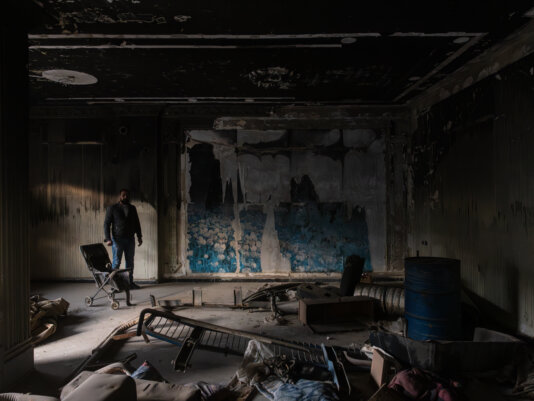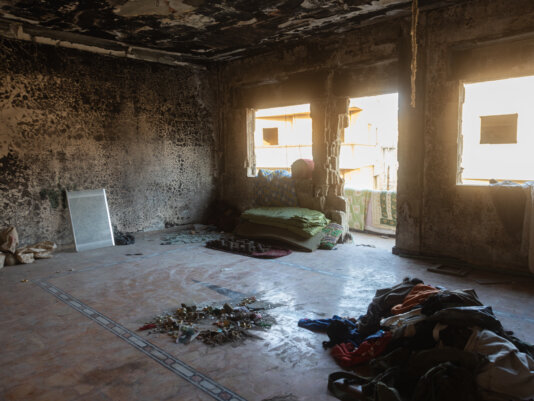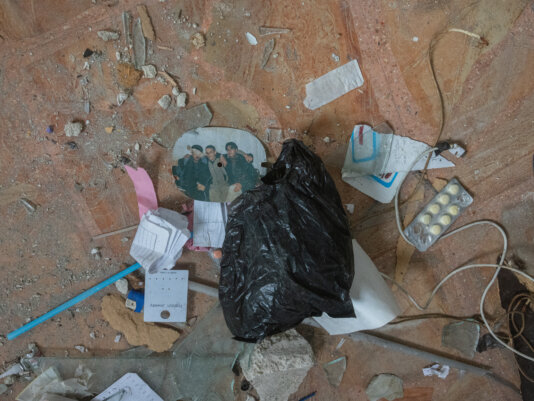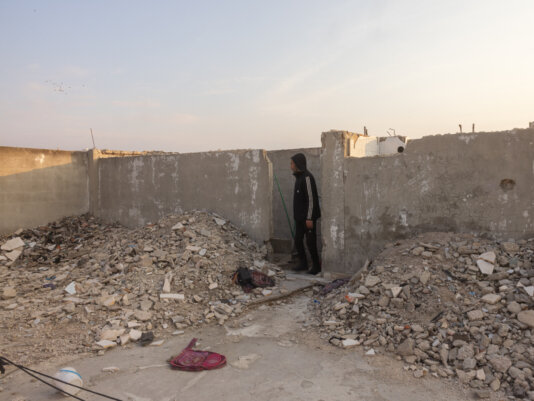- About
- Topics
- Story
- In-Depth
- Picks
- Opinion
- News
- Donate
- Signup for our newsletterOur Editors' Best Picks.Send
Read, Debate: Engage.
| May 12, 2025 | |
|---|---|
| topic: | Refugees and Asylum |
| tags: | #Syria, #Middle-East, #war, #infrastructure, #refugees |
| located: | Syria |
| by: | Andrei Popoviciu |
“I thought they would loot,” al-Khaled told FairPlanet quietly as he walked around what was left of his home, “but not burn and destroy the structure. This was the most beautiful house in the street, now it’s unrecognisable.”
Al-Khaled was one of the residents of the Job al-Jandaley neighborhood in Homs to return the earliest to a place where most were forced to flee 14 years ago as regime tanks rolled in. Now, after the fall of the Assad regime on 8 December last year, hundreds have come back.
By November 2013, roughly half of the city’s 800,000 residents had been displaced by the widespread devastation. As of 2025, 72 per cent of displaced people from Homs said their homes were either completely destroyed or too damaged to live in, while another 19 per cent said their homes needed major repairs.
Homs residents are not alone. The war in Syria forced more than 14 million people from their homes with around 7 million displaced within the country, while nearly 6 million are scattered across neighboring nations like Turkey, Lebanon, Jordan, and Iraq. For over a decade, returning home felt impossible. But after the collapse of the Assad regime a quiet wave of return has begun.
A recent UNHCR survey found that by early 2025, 27 per cent of Syrian refugees returned home in comparison to only 1.4 per cent in 2024. Still, the path home is not an escape from hardship.
The Syrian economy lies in ruins. Inflation is high and more than 16 million people are projected to need humanitarian assistance this year. Food, water and fuel are prohibitively expensive, and unemployment remains low.
Because of that, for many returnees, rebuilding is not possible just yet, but returning is a start and a symbol of reclaiming a country fractured by war and displacement.
Firaz Arahal spent 13 years between Jordan and Lebanon after fleeing the Job al-Jandaley neighbourhood in 2011. Like his neighbours, he fled when regime tanks began shelling. His home was later occupied and stripped bare.
“They took everything, the steel from inside the walls, the marble tiles, the electricity wires,” said Arahal.
He came back seven days after the regime left in December and while he didn’t find much he was happy. “Just by smelling the air here made us forget 14 years of destruction,” he said. “Now everything is okay because we returned. The joy is indescribable.”
His house, once filled with memories, had been turned into a barrack by intelligence officers who used the homes to store stolen windows and furniture. Still, Arahal says he won’t touch the looted goods. “It’s wrong to do that. We’re tired of hate, we forgive them, we just want to be home.”
Al-Khaled’s path back was shaped by resistance during the war. After fleeing in 2011, he joined the Free Syrian Army and fought in battles against the regime and the Hezbollah. His return to Homs was personal as a former rebel reclaiming his corner of a city once overrun by regime forces. His father, once a respected figure in the neighbourhood, had built their home with pride.
“The occupier was an officer with military security, he was the head of the group that took over homes on this street,” Mazer said, “it was punishment. They did this because we joined the revolution.”
Mohammed Sharafidine’s return from Turkey was more than symbolic. It was the first step toward restoring a shattered sense of dignity. He fled in November 2011 after witnessing what he calls an “unspeakable massacre” in his street.
“I cried when I found out I could return,” he said. “I was only 200 kilometres away, yet I couldn’t come back, meanwhile, someone was defiling and destroying our home.”
Now staying with friends while preparing to bring his wife and children back from Turkey, Sharafidine reflects on the absurdity of war. His family was wealthy and was doing well but after the war started he left his home only with the clothes on my back. HIs kids were born in Turkey anddon’t know about Homs, but now he is happy he can show them their origins and where their parents used to live.
Sharafidine managed to reclaim his car after showing proof of ownership to the man who had stolen it. “After 14 years, we’re exhausted,” he said. “We want peace, we don’t want revenge,” he added, referring to the people who occupied his home.
Homs, long regarded by the regime as a rebel stronghold, is among the most devastated cities in Syria, ranking as the fourth most destroyed nationwide. The scale of destruction is staggering everywhere you look: skeletal buildings line the streets, entire neighbourhoods lie in ruins, and basic services are nonexistent.
Swaths of the city still lack electricity and running water, while many homes remain uninhabitable despite the minor repairs residents have tried to make in the first few months since the liberation. The war left behind an estimated 5.3 million tons of rubble in Homs alone.
Image by Alexandra Corcode.
By copying the embed code below, you agree to adhere to our republishing guidelines.



